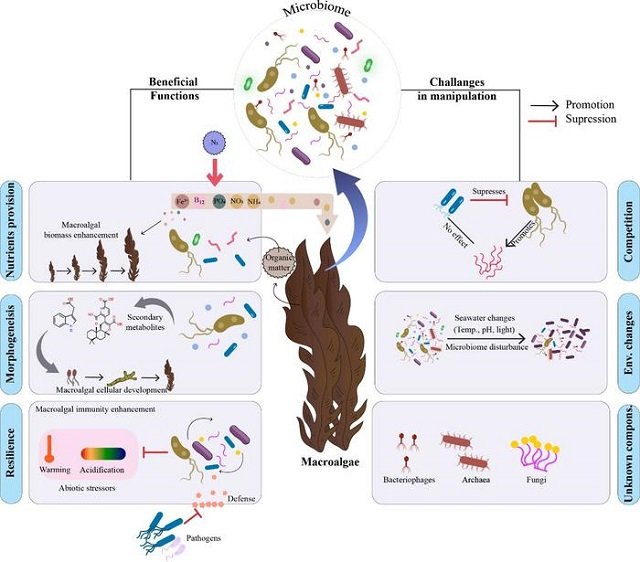
Tilapia, a widely farmed fish species, is known for its omnivorous feeding habits, making it an ideal model to study the influence of diet on the intestinal microbiota. As tilapia grows, its dietary preferences shift from zooplankton to plant-based materials. This transition is accompanied by changes in its intestinal microbial composition.
The intestinal microbiome, a complex community of microorganisms, plays a crucial role in various physiological functions of an organism. In fish, including tilapia, it is influenced by several factors, including genetics, ontogeny, diet, and the environment. Among these, feeding habits significantly impact the structure and function of the intestinal microbiota.
To uncover the intricate relationship between tilapia’s intestinal microbiota and its dietary preferences, researchers from the Chinese Academy of Fishery Science conducted a comprehensive study using shotgun metagenomic sequencing, untargeted metabolomic analysis, and 16S rRNA gene sequencing to study the metabolites and intestinal microbial communities in tilapia fed different diets.
Dietary Effects on Intestinal Microbiota and Metabolites
- 1 Dietary Effects on Intestinal Microbiota and Metabolites
- 2 The Role of Cetobacterium
- 3 Correlation Between Cetobacterium and Metabolites
- 4 Metagenomic Analysis Reveals Functional Diversity
- 5 Impact on Growth and Metabolism
- 6 Implications for Aquaculture Management
- 7 Conclusion
- 8 Entradas relacionadas:
Nile tilapia were fed three distinct diets: carnivorous (Artemia nauplii), herbivorous (plant-based pellet feed), and omnivorous (a combination of both). While the overall microbial structure of the gut remained relatively similar across all dietary groups, significant differences were observed in the abundance of certain intestinal metabolites.
Key Findings
- Diet-induced changes in the microbiome: The study revealed significant differences in the composition of the intestinal microbiota among the three dietary groups. The herbivorous diet was associated with a higher abundance of bacteria involved in plant cell wall degradation, while the carnivorous diet favored bacteria associated with protein digestion.
- Metabolomic changes: The metabolomic profiles of the fish also varied depending on their diets. The herbivorous diet was linked to higher levels of short-chain fatty acids, known for their beneficial effects on gut health.
- Growth performance: The omnivorous diet resulted in the best growth performance, suggesting that a balanced diet incorporating both plant- and animal-based nutrients is optimal for tilapia.
The Role of Cetobacterium
The abundance of the key bacterial genus Cetobacterium was significantly higher in tilapia fed an omnivorous diet. This bacterium was closely linked to specific metabolites, including glucose and amino acids, and was associated with pathways involved in carbohydrate and amino acid metabolism.
Correlation Between Cetobacterium and Metabolites
The abundance of Cetobacterium was strongly correlated with several metabolites, including glucose and amino acids. Additionally, it was associated with pathways involved in carbohydrate and amino acid metabolism, as identified through metagenome analysis.
Metagenomic Analysis Reveals Functional Diversity
Metagenomic classification identified seven metagenome-assembled genomes (MAGs) of Cetobacterium with high completeness and low contamination. These MAGs contained a diverse array of carbohydrate-active enzymes (CAZymes), enabling them to break down both animal and plant glycans. This functional diversity likely contributes to tilapia’s ability to thrive on a variety of diets.
Impact on Growth and Metabolism
Tilapia fed an omnivorous diet showed higher growth rates, possibly linked to specific intestinal metabolites such as aspartate, isoleucine, ornithine, proline, nicotinate, and NAD+. These metabolites may play a crucial role in supporting growth and overall health.
Stay Always Informed
Join our communities to instantly receive the most important news, reports, and analysis from the aquaculture industry.
Implications for Aquaculture Management
The findings of this study provide valuable insights into the nutritional function of tilapia’s intestinal microbiota and its role in adapting to different dietary regimes. This knowledge can be applied to optimize aquaculture practices, including feed formulation and management strategies. By understanding the interaction between diet, gut microbiota, and growth performance, we can improve the sustainability and efficiency of tilapia aquaculture.
Conclusion
The study provides valuable insights into the relationship between feeding habits and gut microbiota in tilapia. The results highlight the importance of dietary diversity in maintaining a healthy gut microbiome and optimizing fish performance. By carefully considering tilapia’s dietary needs and manipulating its feeding regimes, aquaculture producers can enhance the sustainability and efficiency of their operations.
The study was funded by the National Natural Science Foundation of China, China Agriculture Research System of MOF and MARA, Guangdong Basic and Applied Basic Research Foundation, Guangzhou Science and Technology Plan Project, and the Central Public-Interest Scientific Institution Basal Research Fund, CAFS.”
Contact
Xiaoli Ke
Key Laboratory of Tropical and Subtropical Fishery Resource Application and Cultivation , Ministry of Agriculture and Rural Affairs; Guangdong Provincial Key Laboratory of Aquatic Animal Immunology and Sustainable Aquaculture, Pearl River Fisheries Research Institute, Chinese Academy of Fishery Science
Guangzhou, 510380, China
Email: xiaolike2012@163.com
Reference (open access)
Wang, M., Yi, M., Zhang, Z., Fan, Z., Jiang, L., Liu, Z., Wang, Z., Lu, M., Cao, J., & Ke, X. (2024). Effect of Different Feeding Habits on Metabolomics Profiles and Microbiota Composition and Functions of Tilapia Gut. Aquaculture Research, 2024(1), 5545159. https://doi.org/10.1155/2024/5545159
Editor at the digital magazine AquaHoy. He holds a degree in Aquaculture Biology from the National University of Santa (UNS) and a Master’s degree in Science and Innovation Management from the Polytechnic University of Valencia, with postgraduate diplomas in Business Innovation and Innovation Management. He possesses extensive experience in the aquaculture and fisheries sector, having led the Fisheries Innovation Unit of the National Program for Innovation in Fisheries and Aquaculture (PNIPA). He has served as a senior consultant in technology watch, an innovation project formulator and advisor, and a lecturer at UNS. He is a member of the Peruvian College of Biologists and was recognized by the World Aquaculture Society (WAS) in 2016 for his contribution to aquaculture.




